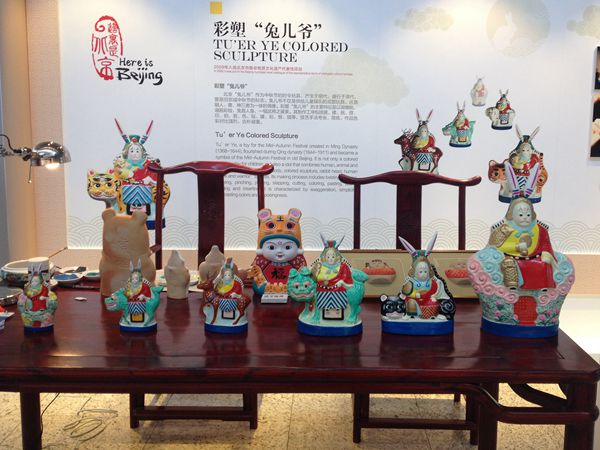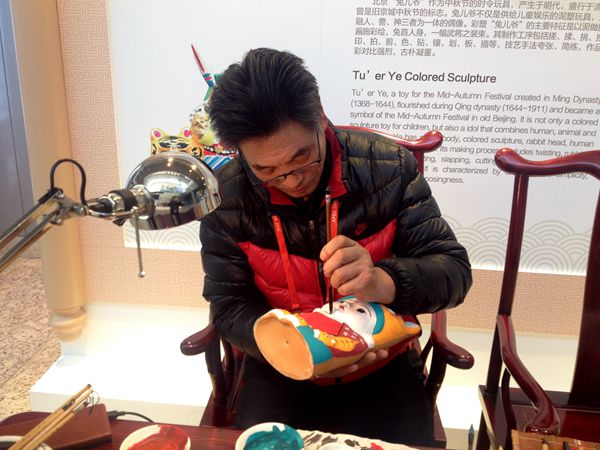Tourists to Beijing are all familiar with a funny-looking sculpture at souvenir shops: a man dressed in an ancient warrior’s dress with rabbit ears and a tiger as his ride. This is the famous “Tu’er Ye”, or rabbit god, a folk deity unique to Beijing. For decades, the sculptures of Tu’er Ye had disappeared, only to be revived by a renowned local sculptor Shuang Qixiang in the 1980s, who passed on his skills to his son Shuang Yan.
The origin of Tu’er Ye
In the past, Tu’er Ye, who has the head of a rabbit and the body of a human, was not just a deity for worshipping. Its clay figures were also used as toys for children. There are many versions of folklores about the origin of Tu’er Ye. The correct version, according to Shuang Yan, is that Tu’er Ye is actually the legendary jade rabbit that was taken to the moon with the goddess Chang’e.
“This is the only cultural item that is truly representative of Beijing because it exists only in the capital city,” Shuang said. Tales of the Tu’er Ye figure goes back to the Ming Dynasty in the 14th century. But Shuang believes it could be even longer than that. “I reckon that it started along with the birth of Beijing as a city.”
Despite the fact that the deity is dressed in man’s clothes, it is actually female. “Based on the traditional values, the rabbit that Chang’e brought with her to the moon is more likely to be female rather than male,” Shuang explained. As for the “Ye” in its name, which literally means “grandpa” or “man” in Chinese, it is in fact a respectful form of address in the Beijing dialect, which could be applied to unmarried senior female relatives in the family.
Though the details of the folklore on Tu’er Ye vary, the essence remains the same. The rabbit, which is a deity itself, came down to earth in the midst of a bad plague in Beijing and dispatched medicines into the wells to help people who had fallen ill. She had to dress herself in man’s clothes which she borrowed from the sculpture in a temple as women were not allowed to walk around in the past.
The plague eventually subsided and many lives were saved. The rabbit, who was too tired, passed out in the temple when she went to return the clothes before leaving. Having learnt the true identity of the “man” who saved them, every year on the Mid-Autumn Day, which falls on the 15th of August in the Chinese lunar calendar, people worship sculptures of the deity and pray that she would protect them from illness for another year.

Shuang Yan's colored sculptures stand at the “This is Beijing” Exhibition at the lobby of the National Conference Center during APEC in November 2014. He was invited to the exhibition as one of the representatives of the local intangible cultural heritage projects. Photo: sino-us.com
The revival of Tu’er Ye
The Tu’er Ye sculptures that are on sale in the tourist boutiques all originated from the sculptures of the Shuang family. Shuang Yan’s father Shuang Qixiang was renowned for his colored sculptures of Tu’er Ye, which he revived single-handedly.
Until the 1950s, Tu’er Ye was a fixture in Beijing, particularly around the Mid-Autumn Festival when the Tu’er Ye sculptures of various sizes and designs were sold by vendors throughout the city. Yet gradually they disappeared. By the time Shuang Qixiang decided to do something about it, there were no copies of the Tu’er Ye design left.
Shuang Qixiang made hundreds of sculptures from memory, which he then took to the seniors who had seen the sculpture before and asked their advice on how to improve. After countless revisions, he settled on the current design. “There is a sculpture of Tu’er Ye from the Qing Dynasty on display at the Forbidden City. Our Tu’er Ye looks exactly the same as that one,” Shuang Yan said proudly.
Shuang Yan has been learning crafts from his father since he was seven. As the successor of the revived Tu’er Ye design, Shuang Yan is not opposed to the idea that the family design is being replicated and sold for profit. However, he is not pleased with the copycats getting the key factors wrong.
“Almost all of the Tu’er Ye sculptures in the market have four flags on their back. Perhaps they think it is symmetrical and therefore more beautiful that way. But there should be only one flag. It is supposed to be representing the flag in front of the temple where Tu’er Ye was found rather than being used as an ornament. Plus Tu’er Ye’s ride could be any traditionally auspicious animal, such as tiger, deer or lion. But it could not be dragon which is associated with emperors only.”
“I have also seen sculptures of ‘Tu’er Nainai’ (Chinese for grandma) which is sold as a two-piece set together with Tu’er Ye,” Shuang Yan shook his head. “That is just ridiculous.”
He was insistent that people should learn the stories behind the sculpture. “It is unique to Beijing and is an essential part of the city’s cultural heritage. It should be protected and passed on correctly.”
Carrying on the tradition
There are two types of traditional colored clay sculptures. One is “full color” and the other is “half color”. Different from “full color” sculptures which are painted over, half-colored sculptures use the natural color of the clay as base, which according to Shuang, is a unique feature of Beijing clay sculptures represented by Tu’er Ye.
Nowadays only half-colored sculptures are made with clay, a particular kind of mud which is becoming more and more difficult to find. Shuang Yan had to follow the construction teams around the city to find the right clay for his sculptures. “The full-colored sculptures are made from pottery instead, due to the short supply of the mud,” he revealed.
Besides making Tu’er Ye, the Shuang family is also known for their facial designs of Beijing Opera figures. Shuang Yan’s father is famous for inventing white clay, a light-weight mixture of paper pulp, calcium carbonate and glue, which can hold its shape well, perfect for making super-sized Beijing Opera facial sculptures that cannot be done with traditional clay. Their gigantic Beijing Opera facial sculptures can be as tall as 1.5 meters and stored for decades.
Shuang Yan’s Tu’er Ye are sold at a very reasonable price, ranging from 80 RMB to 260 RMB depending on the size of the sculpture. The price tag is not high because the design is fixed and cannot be changed. His own designs, however, could be sold at a higher price. For example, a “Hu Wa” (tiger baby) sculpture could be sold at 800 yuan.

Shuang Yan working on one of his own Hu Wa sculptures. Photo: sino-us.com
Shuang Yan’s Tu’er Ye has recently been included into the national intangible cultural heritage list in December, five years after it was inducted into the Beijing municipal-level catalogue of representative items of intangible cultural heritage.
It is Shuang Yan’s sincere wish to keep this tradition alive. His son has been learning from him since 2000. And he is open to anyone who wishes to help carry on the crafts. “But first, they need to learn everything about the culture and history,” the sculptor said.
|
|
||
 |
| Touched | Sympathetic | Bored | Angry | Amused | Sad | Happy | No comment |
Rhythm Media Group is a multi-media company, operating a US-based Chinese daily newspaper, The China Press, and the paper's website - uschinapress.com (which has mobile-app version), as well as a Beijing-based English website Sino-US.com. The group boasts 15 branch offices across the US, and a number of cultural centers focusing on culture-related business in the North America, Chinese mainland, Hong Kong and Taiwan.Launched in September 2012, the Sino-US.com is designed to serve as a bridge between China and the US, and to keep its readership inside or outside China better informed by providing news and insights on China's current affairs, culture, life, business, people and sports.
|
|